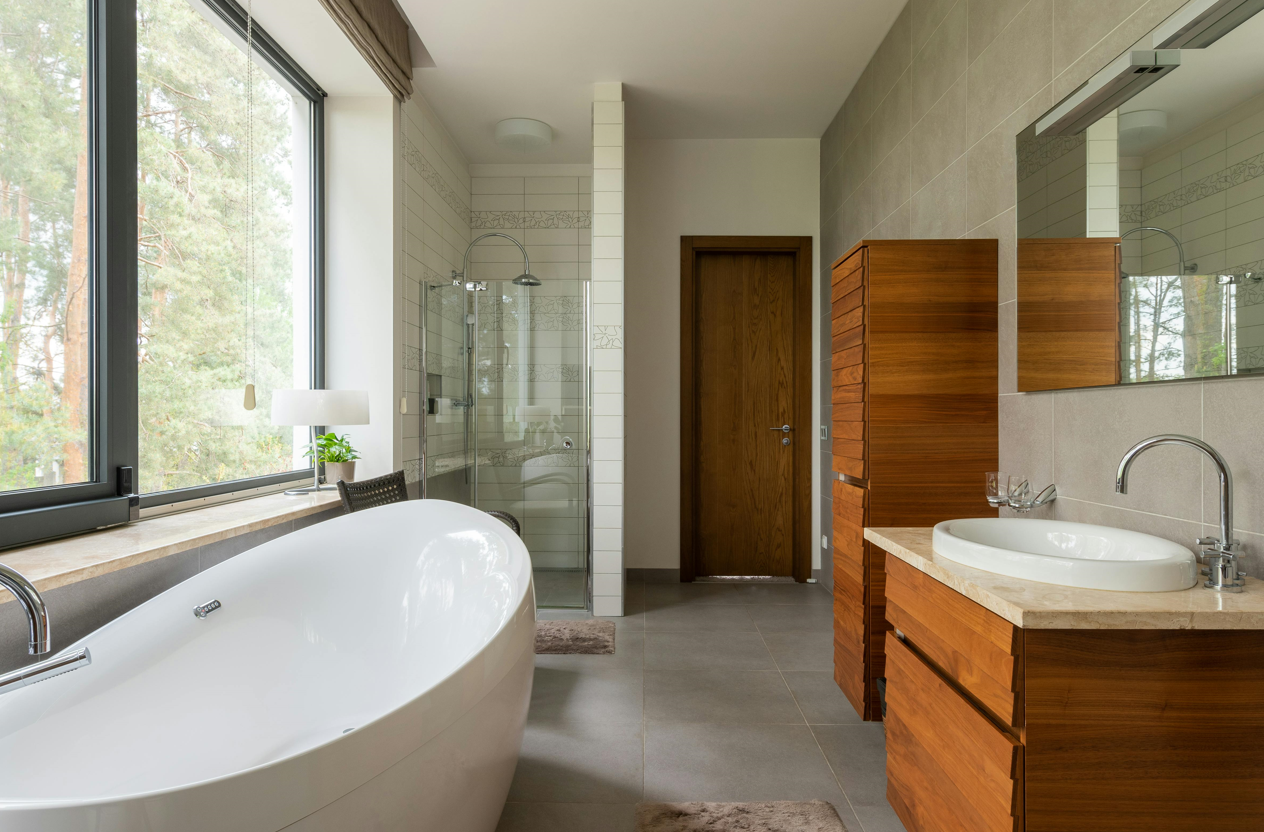Renovating a bathroom can be an exciting yet daunting task. One of the key aspects that often gets overlooked is the plumbing layout and design. Whether you’re transforming a small space or creating a luxurious spa-like retreat, understanding the intricacies of plumbing is crucial. This guide will offer valuable insights into efficient plumbing design, ensuring your new bathroom is as functional as it is beautiful.
Planning Your Plumbing Layout is Crucial
Planning your plumbing layout from the start is essential for a successful bathroom renovation. Efficient plumbing design ensures that water flows smoothly, fixtures function properly, and potential issues are minimized. Incorporating professional plumbing services also helps in avoiding costly mistakes and delays.
Save Time and Money
A well-thought-out plumbing plan can save both time and money. By understanding the locations of existing pipes, drains, and vents, you can design your layout to work with, rather than against, your current setup. This reduces the need for extensive re-piping and minimizes labor costs.
Enhance Functionality
A functional plumbing design increases the usability of your bathroom. Properly placed fixtures, such as sinks, toilets, and showers, ensure that daily routines are seamless and efficient. This consideration is especially important in smaller bathrooms where space optimization is critical.
Avoid Future Problems
Good planning helps in foreseeing potential problems. Identifying the right materials, correct pipe sizes, and appropriate fixture placements can prevent issues like leaks, low water pressure, and blockages. This foresight not only enhances the longevity of your plumbing system but also maintains the integrity of your bathroom design.
Understanding Basic Plumbing Components
Before diving into the specifics of your layout, it’s important to understand the basic components of bathroom plumbing. This knowledge lays the foundation for making informed decisions throughout your renovation process.
Pipes and Fittings
Pipes and fittings are the arteries of your plumbing system, carrying water to and from fixtures. Materials commonly used include copper, PVC, and PEX, each having its advantages. Copper is durable and long-lasting, PVC is cost-effective and corrosion-resistant, and PEX offers flexibility and ease of installation.
Drains and Vents
Drains remove wastewater from your bathroom, while vents allow air to circulate, preventing pressure build-up and ensuring smooth drainage. Proper venting is crucial to avoid slow drains and unpleasant odors. Placing vents strategically can significantly improve the efficiency of your plumbing system.
Fixtures and Faucets
Fixtures like sinks, toilets, and showers are the visible elements of your bathroom, while faucets control the flow of water. Choosing fixtures that match your design aesthetic and functionality needs is essential. High-quality fixtures not only enhance the look of your bathroom but also ensure long-term performance.
Designing Your Plumbing Layout
Once you have a grasp of the basic components, it’s time to design your plumbing layout. This process involves careful planning and consideration of various factors to achieve an efficient and effective system.
Mapping Out the Space
Start by mapping out the existing plumbing. Identify where pipes, drains, and vents are currently located. Use this information to design a layout that minimizes the need for extensive modifications. Working with the existing structure can significantly reduce costs and simplify the renovation process.
Positioning Fixtures
Positioning fixtures correctly is crucial for a functional bathroom. Ensure that sinks, toilets, and showers are placed in convenient and accessible locations. Consider the flow of movement and how each fixture will be used. Proper spacing between fixtures prevents overcrowding and enhances usability.
Ensuring Proper Ventilation
Ventilation is a key aspect of plumbing design that often goes unnoticed. Properly vented drains prevent clogs and maintain smooth water flow. Incorporate vents into your layout to ensure a balanced and efficient system. This step is essential for maintaining the overall health and hygiene of your bathroom.
Choosing the Right Plumbing Materials
The materials you choose for your plumbing system can significantly impact its performance and longevity. Selecting the right materials ensures durability, efficiency, and ease of maintenance.
Copper Pipes
Copper pipes are known for their durability and resistance to corrosion. They are a popular choice for both hot and cold water lines. Copper is also bacteriostatic, meaning it inhibits the growth of bacteria, ensuring a clean and safe water supply.
PVC Pipes
PVC pipes are a cost-effective option for drain, waste, and vent systems. They are resistant to corrosion and chemical damage, making them ideal for bathroom plumbing. PVC is also lightweight and easy to work with, reducing installation time and labor costs.
PEX Pipes
PEX pipes offer flexibility and ease of installation. They can be bent around corners without the need for additional fittings, reducing potential leak points. PEX is also resistant to freezing, making it a reliable option for both hot and cold water lines.
Incorporating Modern Plumbing Innovations
Modern plumbing innovations can enhance the functionality and efficiency of your bathroom. Incorporating these advancements into your design can elevate your renovation project to the next level.
Tankless Water Heaters
Tankless water heaters provide hot water on demand, reducing energy consumption and saving space. They are ideal for small bathrooms where every inch counts. These heaters also have a longer lifespan compared to traditional tank systems, offering long-term benefits.
Water-Saving Fixtures
Water-saving fixtures, such as low-flow toilets and faucets, help reduce water consumption without compromising performance. These fixtures are designed to provide optimal functionality while conserving water, making them an eco-friendly choice for modern bathrooms.
Smart Plumbing Systems
Smart plumbing systems offer advanced features like leak detection, automatic shut-off, and remote monitoring. These systems provide peace of mind by alerting you to potential issues before they become major problems. Incorporating smart technology into your plumbing design ensures a modern and efficient bathroom.
Coordinating with Professionals
Working with professionals can make a significant difference in the success of your renovation project. Experienced plumbers and contractors bring expertise and knowledge, ensuring that your plumbing design is executed flawlessly.
Hiring a Plumbing Contractor
Hiring a reputable plumbing contractor is crucial for a smooth renovation process. Look for contractors with experience in bathroom renovations and positive customer reviews. A skilled contractor can provide valuable insights and recommendations, ensuring that your plumbing system meets all safety standards and regulations.
Collaborating with Designers
Collaborating with designers can help you achieve a cohesive and aesthetically pleasing bathroom. Designers have an eye for detail and can suggest creative solutions to maximize space and functionality. Working together with a designer ensures that your plumbing layout complements the overall design of your bathroom.
Scheduling Inspections
Scheduling regular inspections throughout the renovation process ensures that everything is on track and meets code requirements. Inspections help identify potential issues early on, allowing for timely adjustments. This proactive approach ensures a successful and hassle-free renovation.
Maintaining Your New Plumbing System
Proper maintenance is essential to keep your new plumbing system in top condition. Regular upkeep ensures that your bathroom remains functional and efficient for years to come.
Regular Inspections
Conduct regular inspections of your plumbing system to check for leaks, clogs, and other issues. Early detection and prompt repairs prevent minor problems from escalating into major ones. Regular maintenance also extends the lifespan of your plumbing fixtures and components.
Cleaning and Care
Cleaning and care are crucial for maintaining the appearance and functionality of your bathroom fixtures. Use gentle cleaning products and avoid harsh chemicals that can damage surfaces. Regular cleaning prevents the buildup of grime and keeps your bathroom looking fresh and inviting.
Professional Servicing
Schedule professional servicing for your plumbing system at least once a year. Professional plumbers can perform thorough inspections, cleanings, and necessary repairs. Regular servicing ensures that your plumbing system operates efficiently and minimizes the risk of unexpected issues.
Renewing Your Bathroom Space
When renovating your bathroom with a well-planned plumbing layout and design, you can transform your space into a functional and stylish oasis. Understanding the basics of plumbing components, designing an efficient layout, choosing the right materials, and incorporating modern innovations are crucial for a successful renovation. Coordinating with professionals like Oak Creek Plumbing and maintaining your new plumbing system ensures long-term performance and satisfaction.









